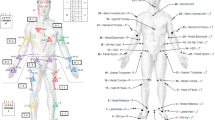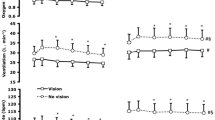Abstract
While vision obviously plays an essential role in orienting and obstacle avoidance, its role in the regulation of dynamic balance is not yet fully understood. The objective of this study was to assess dynamic stability while blindfolded, under optimal conditions that minimized the fear of falling. The hypothesis was that visual deprivation could be compensated for by using other sensory strategies to stabilize gait. One hundred healthy adults (aged 20–69 years) participated in the study. They were previously accustomed to blindfolded treadmill walking wearing a safety harness. Their preferred walking speeds (PWS) were assessed with eyes open (PWSEO) and with eyes closed (blindfolded, PWSEC). Three five-minute tests were performed: (A) normal walking at PWSEO, (B) blindfolded walking at PWSEC, and (C) normal walking at PWSEC. Trunk acceleration was measured with a lightweight inertial sensor. Dynamic stability was assessed by using (1) acceleration root mean square (RMS), which estimates the variability of the signal, and hence, the smoothness of the trunk movement and (2) local dynamic stability (LDS), which reflects the efficiency of the motor control to stabilize the trunk. Although walking at PWSEC with eyes open (comparing conditions A and C) had a slight impact on gait stability (relative difference: RMS +4 %, LDS −5 %), no destabilizing effect of visual deprivation (B vs. C, RMS −4 %, LDS −1 %) was observed. Therefore, it is concluded that when reassuring conditions are offered to individuals while walking, they are able to adopt alternative sensory strategies to control dynamic equilibrium without the help of vision.





Similar content being viewed by others
References
Aaslund MK, Moe-Nilssen R (2008) Treadmill walking with body weight support: effect of treadmill, harness and body weight support systems. Gait Posture 28:303–308
Bauby CE, Kuo AD (2000) Active control of lateral balance in human walking. J Biomech 33:1433–1440
Bruijn S, Bregman D, Meijer O, Beek P, van Dieen J (2012) Maximum Lyapunov exponents as predictors of global gait stability: a modelling approach. Med Eng Phys 34:428–436
Bruijn SM, Meijer OG, Beek PJ, van Dieën JH (2013) Assessing the stability of human locomotion: a review of current measures. J R Soc Interface 10:20120999
Cohen J (1994) The earth is round (p < . 05). Am Psychol 49:997
Cui X, Peng C-K, Costa MD, Weiss A, Goldberger AL, Hausdorff JM (2014) Development of a new approach to quantifying stepping stability using ensemble empirical mode decomposition. Gait Posture 39:495–500
Decker LM, Cignetti F, Stergiou N (2012) Wearing a safety harness during treadmill walking influences lower extremity kinematics mainly through changes in ankle regularity and local stability. J Neuroeng Rehabil 9:8
Dingwell JB (2006) Lyapunov exponents. Wiley Encyclopedia of Biomedical Engineering
Dingwell JB, Cusumano JP (2000) Nonlinear time series analysis of normal and pathological human walking. Chaos 10:848–863
Dingwell JB, Marin LC (2006) Kinematic variability and local dynamic stability of upper body motions when walking at different speeds. J Biomech 39:444–452
Dingwell JB, Cusumano JP, Cavanagh PR, Sternad D (2001) Local dynamic stability versus kinematic variability of continuous overground and treadmill walking. J Biomech Eng 123:27–32
Fell J, Roschke J, Beckmann P (1993) Deterministic chaos and the first positive Lyapunov exponent: a nonlinear analysis of the human electroencephalogram during sleep. Biol Cybern 69:139–146
Fukuyama H, Ouchi Y, Matsuzaki S et al (1997) Brain functional activity during gait in normal subjects: a SPECT study. Neurosci Lett 228:183–186
Hak L, Houdijk H, Steenbrink F, Mert A, van der Wurff P, Beek PJ, van Dieen JH (2012) Speeding up or slowing down?: Gait adaptations to preserve gait stability in response to balance perturbations. Gait Posture 36:260–264
Hallemans A, Beccu S, Van Loock K, Ortibus E, Truijen S, Aerts P (2009a) Visual deprivation leads to gait adaptations that are age- and context-specific: I. Step-time parameters. Gait Posture 30:55–59
Hallemans A, Beccu S, Van Loock K, Ortibus E, Truijen S, Aerts P (2009b) Visual deprivation leads to gait adaptations that are age- and context-specific: II. Kinematic parameters. Gait Posture 30:307–311
Hallemans A, Ortibus E, Meire F, Aerts P (2010) Low vision affects dynamic stability of gait. Gait Posture 32:547–551
Helbostad JL, Moe-Nilssen R (2003) The effect of gait speed on lateral balance control during walking in healthy elderly. Gait Posture 18:27–36
Henriksen M, Lund H, Moe-Nilssen R, Bliddal H, Danneskiod-Samsoe B (2004) Test-retest reliability of trunk accelerometric gait analysis. Gait Posture 19:288–297
Hilfiker R, Vaney C, Gattlen B et al (2013) Local dynamic stability as a responsive index for the evaluation of rehabilitation effect on fall risk in patients with multiple sclerosis: a longitudinal study. BMC Res Notes 6:260
Iosa M, Fusco A, Morone G, Paolucci S (2012a) Effects of visual deprivation on gait dynamic stability. Sci World J 2012:974560
Iosa M, Fusco A, Morone G et al (2012b) Assessment of upper-body dynamic stability during walking in patients with subacute stroke. J Rehabil Res Dev 49:439–450
Iosa M, Fusco A, Morone G, Paolucci S (2014) Development and decline of upright gait stability. Front Aging Neurosci 6:14
Kavanagh JJ, Menz HB (2008) Accelerometry: a technique for quantifying movement patterns during walking. Gait Posture 28:1–15
Kavanagh J, Barrett R, Morrison S (2006) The role of the neck and trunk in facilitating head stability during walking. Exp Brain Res 172:454–463
Lorenz E (1972) Predictability: Does the flap of a butterfly’s wings in Brazil set off a tornado in Texas. Presented before the American Association for the Advancement of Science, December 29
Manor B, Wolenski P, Guevaro A, Li L (2009) Differential effects of plantar desensitization on locomotion dynamics. J Electromyogr Kinesiol 19:e320–e328
McAndrew PM, Wilken JM, Dingwell JB (2011) Dynamic stability of human walking in visually and mechanically destabilizing environments. J Biomech 44:644–649
Mignardot J-B, Deschamps T, Barrey E, et al (2014) Gait disturbances as specific predictive markers of the first fall onset in elderly people. Front Aging Neurosci 6:22
Moe-Nilssen R (1998a) A new method for evaluating motor control in gait under real-life environmental conditions. Part 1: the instrument. Clin Biomech 13:320–327
Moe-Nilssen R (1998b) A new method for evaluating motor control in gait under real-life environmental conditions. Part 2: gait analysis. Clin Biomech 13:328–335
Moe-Nilssen R, Helbostad JL, Akra T, Birdedal L, Nygaard HA (2006) Modulation of gait during visual adaptation to dark. J Mot Behav 38:118–125
Musienko P, Courtine G, Tibbs JE et al (2012) Somatosensory control of balance during locomotion in decerebrated cat. J Neurophysiol 107:2072–2082
Nakagawa S, Cuthill IC (2007) Effect size, confidence interval and statistical significance: a practical guide for biologists. Biol Rev Camb Philos Soc 82:591–605
Patla AE (1997) Understanding the roles of vision in the control of human locomotion. Gait Posture 5:54–69
Reynard F, Terrier P (2014) Local dynamic stability of treadmill walking: intrasession and week-to-week repeatability. J Biomech 47:74–80
Riva F, Toebes M, Pijnappels M, Stagni R, van Dieen J (2013) Estimating fall risk with inertial sensors using gait stability measures that do not require step detection. Gait Posture 38:170–174
Roos P, Dingwell J (2010) Influence of simulated neuromuscular noise on movement variability and fall risk in a 3D dynamic walking model. J Biomech 43:2929–2935
Rosenstein M, Collins J, De Luca C (1993) A practical method for calculating largest lyapunov exponents from small data sets. Physica D 65:117–134
Rota V, Perucca L, Simone A, Tesio L (2011) Walk ratio (step length/cadence) as a summary index of neuromotor control of gait: application to multiple sclerosis. Int J Rehabil Res 34:265–269
Schutz Y, Weinsier S, Terrier P, Durrer D (2002) A new accelerometric method to assess the daily walking practice. Int J Obes Relat Metab Disord 26:111–118
Sekine M, Tamura T, Yoshida M et al (2013) A gait abnormality measure based on root mean square of trunk acceleration. J Neuroeng Rehabil 10:118
Sekiya N, Nagasaki H (1998) Reproducibility of the walking patterns of normal young adults: test-retest reliability of the walk ratio(step-length/step-rate). Gait Posture 7:225–227
Sloot LH, van Schooten KS, Bruijn SM, Kingma H, Pijnappels M, van Dieen JH (2011) Sensitivity of local dynamic stability of over-ground walking to balance impairment due to galvanic vestibular stimulation. Ann Biomed Eng 39:1563–1569
Sprott JC (2003) Chaos and time-series analysis. Oxford University Press, Oxford
Strogatz S (2001) Nonlinear dynamics and chaos: with applications to physics, biology, chemistry and engineering. Perseus Publishing, New York
Takens F (1980) Detecting strange attractors in turbulence. In: Rands D, Young LS (eds) Dynamical systems and turbulence. Springer, Berlin, pp 366–381
Terrier P, Dériaz O (2011) Kinematic variability, fractal dynamics and local dynamic stability of treadmill walking. J Neuroeng Rehabil 8:12
Terrier P, Dériaz O (2013) Non-linear dynamics of human locomotion: effects of rhythmic auditory cueing on local dynamic stability. Front Physiol 4:230
Terrier P, Reynard F (2015) Effect of age on the variability and stability of gait: a cross-sectional treadmill study in healthy individuals between 20 and 69 years of age. Gait Posture 41:170–174
Toebes MJ, Hoozemans MJ, Furrer R, Dekker J, van Dieen JH (2012) Local dynamic stability and variability of gait are associated with fall history in elderly subjects. Gait Posture 36:527–531
van Schooten KS, Sloot LH, Bruijn SM, Kingma H, Meijer OG, Pijnappels M, van Dieen JH (2011) Sensitivity of trunk variability and stability measures to balance impairments induced by galvanic vestibular stimulation during gait. Gait Posture 33:656–660
van Schooten KS, Rispens SM, Pijnappels M, Daffertshofer A, van Dieen JH (2013) Assessing gait stability: the influence of state space reconstruction on inter- and intra-day reliability of local dynamic stability during over-ground walking. J Biomech 46:137–141
Varraine E, Bonnard M, Pailhous J (2002) Interaction between different sensory cues in the control of human gait. Exp Brain Res 142:374–384
Acknowledgments
The authors wish to thank Olivier Dériaz for his support. This study was supported by the Swiss accident insurance company SUVA, which is an independent, non-profit company under public law and by Clinique romande de réadaptation. The IRR is supported by the State of Valais and the City of Sion.
Author information
Authors and Affiliations
Corresponding author
Electronic supplementary material
Below is the link to the electronic supplementary material.
Rights and permissions
About this article
Cite this article
Reynard, F., Terrier, P. Role of visual input in the control of dynamic balance: variability and instability of gait in treadmill walking while blindfolded. Exp Brain Res 233, 1031–1040 (2015). https://doi.org/10.1007/s00221-014-4177-5
Received:
Accepted:
Published:
Issue Date:
DOI: https://doi.org/10.1007/s00221-014-4177-5




